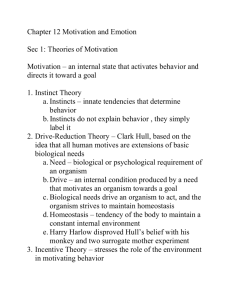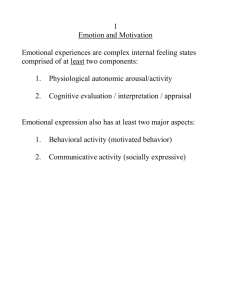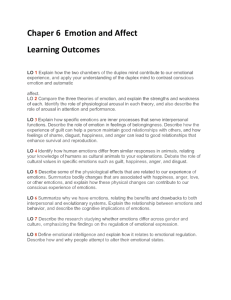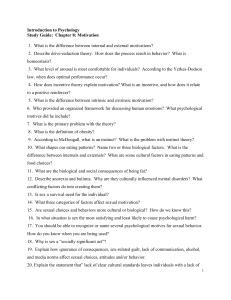Print › Ch 10 - Motivation and Emotion | Quizlet | Quizlet
advertisement
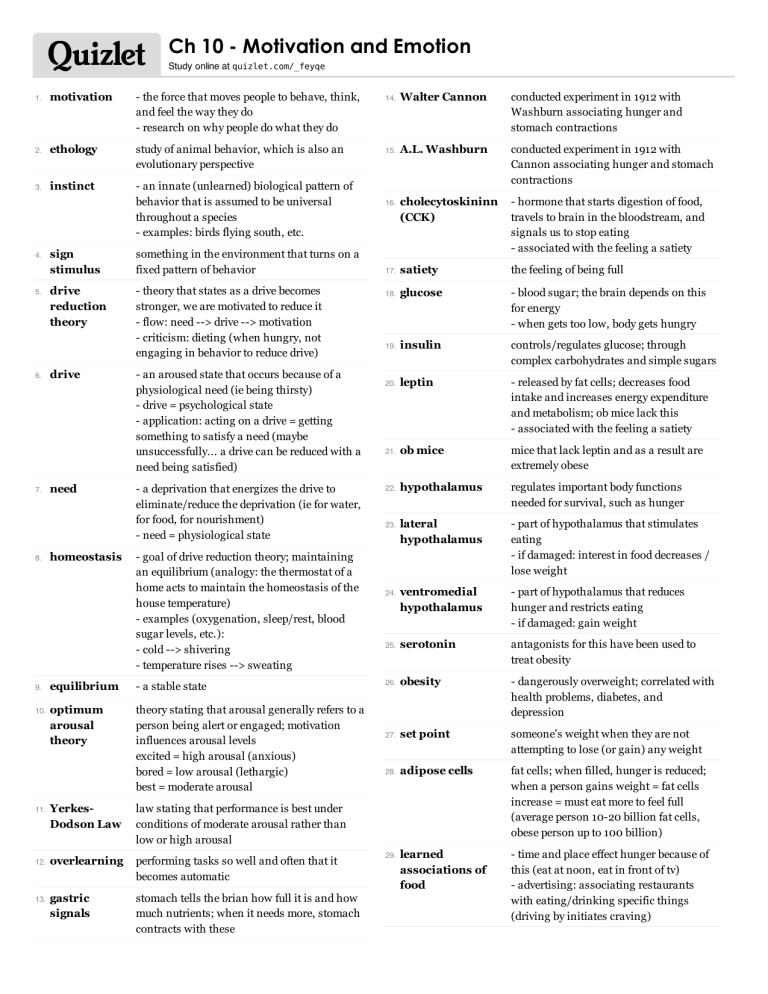
Ch 10 - Motivation and Emotion Study online at quizlet.com/_feyqe 1. motivation - the force that moves people to behave, think, and feel the way they do - research on why people do what they do 2. ethology study of animal behavior, which is also an evolutionary perspective 3. instinct - an innate (unlearned) biological pattern of behavior that is assumed to be universal throughout a species - examples: birds flying south, etc. 4. 5. 6. 7. 8. 9. 10. 11. 12. 13. sign stimulus something in the environment that turns on a fixed pattern of behavior drive reduction theory - theory that states as a drive becomes stronger, we are motivated to reduce it - flow: need --> drive --> motivation - criticism: dieting (when hungry, not engaging in behavior to reduce drive) drive need homeostasis - an aroused state that occurs because of a physiological need (ie being thirsty) - drive = psychological state - application: acting on a drive = getting something to satisfy a need (maybe unsuccessfully... a drive can be reduced with a need being satisfied) - a deprivation that energizes the drive to eliminate/reduce the deprivation (ie for water, for food, for nourishment) - need = physiological state - goal of drive reduction theory; maintaining an equilibrium (analogy: the thermostat of a home acts to maintain the homeostasis of the house temperature) - examples (oxygenation, sleep/rest, blood sugar levels, etc.): - cold --> shivering - temperature rises --> sweating equilibrium - a stable state optimum arousal theory theory stating that arousal generally refers to a person being alert or engaged; motivation influences arousal levels excited = high arousal (anxious) bored = low arousal (lethargic) best = moderate arousal YerkesDodson Law law stating that performance is best under conditions of moderate arousal rather than low or high arousal overlearning performing tasks so well and often that it becomes automatic gastric signals stomach tells the brian how full it is and how much nutrients; when it needs more, stomach contracts with these 14. Walter Cannon conducted experiment in 1912 with Washburn associating hunger and stomach contractions 15. A.L. Washburn conducted experiment in 1912 with Cannon associating hunger and stomach contractions cholecytoskininn (CCK) - hormone that starts digestion of food, travels to brain in the bloodstream, and signals us to stop eating - associated with the feeling a satiety 17. satiety the feeling of being full 18. glucose - blood sugar; the brain depends on this for energy - when gets too low, body gets hungry 19. insulin controls/regulates glucose; through complex carbohydrates and simple sugars 20. leptin - released by fat cells; decreases food intake and increases energy expenditure and metabolism; ob mice lack this - associated with the feeling a satiety 21. ob mice mice that lack leptin and as a result are extremely obese 22. hypothalamus regulates important body functions needed for survival, such as hunger lateral hypothalamus - part of hypothalamus that stimulates eating - if damaged: interest in food decreases / lose weight ventromedial hypothalamus - part of hypothalamus that reduces hunger and restricts eating - if damaged: gain weight 25. serotonin antagonists for this have been used to treat obesity 26. obesity - dangerously overweight; correlated with health problems, diabetes, and depression 27. set point someone's weight when they are not attempting to lose (or gain) any weight 28. adipose cells fat cells; when filled, hunger is reduced; when a person gains weight = fat cells increase = must eat more to feel full (average person 10-20 billion fat cells, obese person up to 100 billion) learned associations of food - time and place effect hunger because of this (eat at noon, eat in front of tv) - advertising: associating restaurants with eating/drinking specific things (driving by initiates craving) 16. 23. 24. 29. 30. 31. 32. 33. 34. 35. 36. 37. disordered eating eating that is characterized by extreme disturbances in eating behavior- eating very little or a great deal anorexia nervosa - an eating disorder that involves the relentless pursuit of thinness through starvation - even when thin, desire to lose weight remains (intense fear of gaining weight - has the highest death rate of any psychological disorder - associated with amenorrhea (loss of periods) - associated with distorted body image bulimia nervosa - an eating disorder with which an individual (usually female) follows a binge-and-purge eating pattern; hard to detect because normally a normal weight - binging may involve consuming enormous amounts of calories at once (example: 5,000) - purging may be through vomiting, laxatives or exercise - high risk: high standards combined with low self-esteem binge eating disorder (BED) an eating disorder characterized by recurrent episodes of consuming large amounts of food during which the person feels a lack of control over eating; no purging afterwards; most are overweight or obese Abraham Maslow - human theorist, created the hierarchy of needs - motivation is primarily the result of satisfying basic needs before moving on to higher needs hierarchy of needs selfactualization esteem - this must be satisfied in the following sequence: physiological needs, safety, love and belongingness, esteem, and selfactualization - application: must meet physiological needs before feeling save; must feel safe before love; etc. - created by Abraham Maslow - motivation to develop one's full potential as a human being - the highest and most elusive of Maslow's proposed needs - top of the pyramid - according to Maslow, only possible after all other needs are met most stop after achieving this level in Maslow's hierarchy of needs; a feeling of accomplishment, such as through a good career love and belonging - level in Maslow's hierarchy of needs that involves positive relations with others, such as friendships, family, and romantic relationships - middle of the pyramid safety level in Maslow's hierarchy of needs that involves feeling secure, having a secure house and neighborhood, police station nearby, etc physiological needs - level in Maslow's hierarchy of needs that involves the basic needs of food, drink, shelter, sex, sleep; the strongest of human needs - bottom of the pyramid selfdetermination theory - all humans have three basic, innate organismic needs: competence, relatedness, and autonomy - study tip: you can determine your own life with CAR - C - competence - A - autonomy - R - relatedness - valued by both Western and Eastern cultures - Eastern culture values affiliation, cooperation and interdependence more than Western/individualistic cultures 42. organismic innate/unlearned qualities that exist in every person 43. competence - part of self determination theory; the feeling that we are able to bring about desired outcomes - reflected in the desire to explore and grow as a person 44. self-efficacy involved in competence; the belief that you can accomplish goals 45. mastery involved in competence; the sense that you can gain skills and overcome obstacles 46. relatedness part of self-determination theory; the need to engage in warm relations with others 47. autonomy - part of self-determination theory; the sense that we are in control of our own lives - promoted more in Western/individualistic societies 48. individualistic wester cultures that focus on the individual, independence, and self accomplishments 49. collectivistic cultures that focus on the group, interdependence, and collaborative efforts intrinsic motivation motivation based on internal factors such as organismic needs (competence, relatedness, autonomy), as well as curiosity, challenge, and fun; psychologists believe this is the key to achievement 38. 39. 40. 41. 50. 51. 52. 53. 54. 55. 56. 57. 58. 59. 60. 61. extrinsic motivation - motivation that involves external incentives such as rewards and punishments - impact depends on if behavior is rewarded, the quality of the reward and the availability of additional rewards - focusing on these (such as money, prestige, physical appearance, etc.) leads to lowered self-actualization, more physical illness, lowered well-being Judy Cameron - found extrinsic motivation has no overall impact on intrinsic motivation (critical controversy, opposing Edward Deci) Edward Deci - found extrinsic motivation can interfere with intrinsic motivation (critical controversy, opposing Judy Cameron) selfregulation - the process by which an organism effortfully controls behavior in order to pursue important objectives - goals that are short-term, specific and challenging lead to greater achievement - delayed gratification succes --> focusing on other activities - involves setting goals, planning for implementation of goals and monitoring progress purpose the intention to accomplish a goal that is meaningful to oneself and to contribute to the world goals - as part of self-regulation theory: personal projects, best possible selves, personal strivings selfmonitoring - as part of self-regulation theory: daily moods give feedback --> cannot always be positive (thus, not always happy with feedback) emotion the feeling or affect that can involve physiological arousal (fast heartbeat), conscious experience (thinking about being in love), and behavioral expression (smiling or grimacing) - F - feeling - T - thinking - B - behaving arousal level of alertness of the body; the Autonomic Nervous System regulates this autonomic nervous system (ANS) body system that takes messages to/from organs, and monitors breathing, heart rate, and digestion sympathetic nervous system (SNS) body system that is responsible for arousal; fight/flight response; increases hear rate, breathing, blood flow and blood pressure parasympathetic nervous system (PNS) - body system that calms the body; heart rate and blood pressure drop, breathing slows, stomach activity and digestion increase - criticism: different emotions can cause the range of physiological changes skin conductance level (SCL) a rise in skin's electrical concuctivity because of sweat glands polygraph - a machine commonly called a lie detector that monitors changes in the body (physiological responses) to determine when a person is lying - most effective factor: belief it is accurate in detecting deceptions - criticisms: - correct slightly more than 50% of the time - anxiety can lead to false positives - different emotions can cause the same physiological reactions - people can be taught be beat polygraph tests functional magnetic brain imaging (fMRI) may be more accurate than a polygraph; records changes in the prefrontal cortex; correct around 71% of the time James-Lange Theory - theory that emotion results form physiological states triggered by stimuli in environment (afraid because running away); also each emotion has particular set of physiological changes - application: make conclusions about emotions based on body's physiological state - supported by the facial feedback hypothesis Cannon-Bard theory theory that emotion and physiological reactions occur simultaneously; also that different emotions cannot be classified by a particular set of physiological changes 68. amygdala in the limbic system, houses circuits that activate when experiencing negative emotions 69. fear - can be experiences through two pathways (direct pathway, indirect pathway) 70. direct pathway path used in life-or-death situations; thalamus => amygdala; not great detail, but fast 71. indirect pathway used in less intense situations; sensory organs => thalamus => sensory cortex => amygdala; slower, more details 72. Stanly Schachter created two-factor theory of emotion 62. 63. 64. 65. 66. 67. 73. 74. 75. 76. 77. Jerome Singer helped create the two-factor theory of emotion two-factor theory of emotion - theory that emotion is determined by two factors: physiological arousal and cognitive labeling - cognitive approach - high arousal can lead to inaccurate labeling of emotions Capilano River bridge experiment - men found the experimenter on the high bridge more sexually attractive than the one on the low bridge - showed that high arousal can lead to inaccurate labeling of emotions (application of the two-factor theory of emotion) primacy debate: cognition or emotion - Lazarus believes that thinking comes first; probably right with cluster of evens and with long-term emotional reactions such as depression (believed in the primacy of thinking, meaning thoughts are a precondition of emotions) - Zajonc believes that emotion comes first"preferences need no inferences"; probably right with single events/preferences, and instantaneous reactions (shrieking) 86. - hypothesis that facial expressions can influence emotions as well as reflect them - supports the James-Lange theory --> theory that emotion results form physiological states triggered by stimuli in environment (afraid because running away) - facial expressions have strong biological ties - application: smiling -> increases happiness; frowning -> decreases happiness 89. facial feedback hypothesis "The Expression of the the Emotions in Man and Animals" - Charles Darwin's study, concluded that facial expression are innate/unlearned - facial expression of emotions does not vary significantly across cultures display rules sociocultural standards that determine when, where, and how emotions should be expressed; varies by culture 80. emoticons characters made through typing that show emotion over computer communication 81. valence - in reference to emotions, categorizes them as either positive (positive affect) or negative (negative affect) - does not reference the intensity of emotion negative affect part of valence; unpleasant emotions such as anger, guilt, and sadness positive affect part of valence; pleasant emotions such as joy, happiness, and interest 78. 79. 82. 83. 84. 85. 87. 88. 90. arousal level the degree to which the emotion is reflected in an individual's being active, engaged, or excited v. passive, disengaged, or calm circumplex model of mood - (a.k.a. wheel model of emotions) uses both valence and arousal level to identify emotions - ecstasy and excitement- high arousal positive emotions - contentment and tranquility- low arousal positive emotions - rage, fury, and panic- high arousal negative emotions - irritation and boredom- low arousal negative emotions broaden-andbuild model - Fredrickson's model of positive emotion stating that the function of positive emotions lies in their effects on an individual's attention and ability to build resources - shows adaptiveness of positive emotions resilience the ability to thrive during difficult times happiness set point one's basic level of happiness when one is not intentionally trying to increase happiness hedonic treadmill belief that any aspect of one's life that enhances one's positive feelings is likely to do so only for a short time because eventually the body adjusts and returns to one's happiness set point goals and happiness (relationship) -happiness comes from having meaningful/personal goals that reflect intrinsic needs of relatedness, competence, and autonomy -goals should be moderately challenging and connected to one another -goals change by life experience, so less susceptible to hedonic treadmill = more happy -goals can make us feel happy or unhappy if not accomplished, which keeps life interesting and their effect on happiness does not wear off! - engaging in altruistic behavior increases happiness
